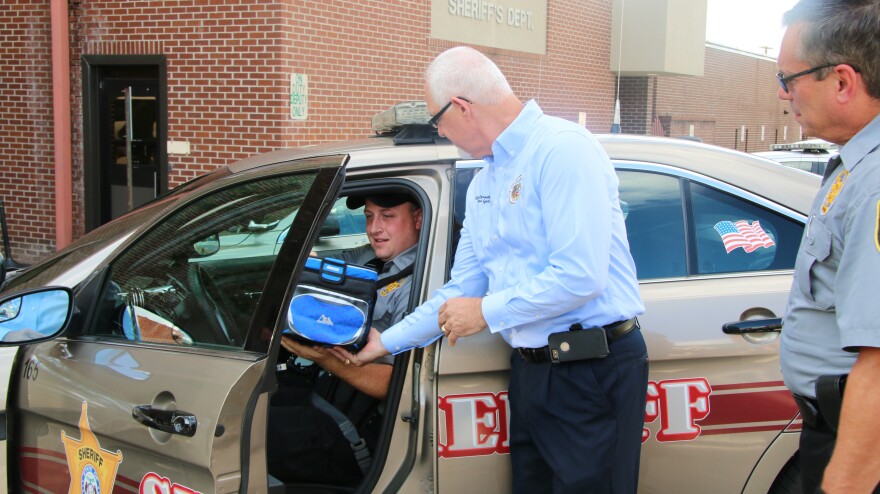In August, the Pulaski County, Missouri, police captain Johnny Burgess ran his team through a new kind of training exercise. Divided into pairs, each officer practiced plunging a nasal atomizer into the nostril of the other. Burgess cautioned them not to push too hard: “You’re not digging for gold.”

They were learning to dose a potential victim with intranasal naloxone, or Narcan, a drug that can instantly reverse an opioid overdose. The training was the culmination of months of effort by the Pulaski County Sheriff’s department to overcome logistical hurdles and outfit its officers with the overdose antidote.
Many other states have saved lives by getting naloxone into the hands of police, who are often the first on the scene of an overdose. And Missouri legalized its use for law enforcement over a year ago. But small, rural Pulaski County is the first in the state to make it a priority. And the sheriff’s department‘s new training protocol will now likely be used statewide.
Pulaski County is a rural county of around 52,000 people. They have an overdose problem—yes—but they are nowhere near the worst in the state. St. Louis County – not including St. Louis city – had 113 heroin-related deaths in 2014.
But it was this community’s residents, their state representative and Sheriff Ron Long who pushed to get the law passed last year that allowed police to use naloxone. The issue is personal for Long, as he saw several young people die within his first few weeks in office as Pulaski County Sheriff.
“How can you not be compassionate when you see how life really is out there?” he said. “And by doing something small and by spending a few dollars you can actually help an individual - maybe even save their life.”
So Long, along with a concerned group of residents, approached their state representative to make first responder use of naloxone a priority. And then last July, a law was passed that allowed just that.

Long said he thinks police officers have an important role to play in the health of their communities because there are part of the community and interact with people every day.
In other states it’s become common for law enforcement to carry the drug. New York reported over 100 lives saved in 2014. And Georgia, since last year, has reported 36.
But law enforcement in Missouri have been slow to start naloxone programs. Many law enforcement agencies have raised concerns about cost, liability and the shelf life of the drug.
Long said his department did face some obstacles, but one by one they found solutions.
“This has been long in the making, but it’s worth every bit of sweat, tears, [that] have gone into this program,” he said.
"This has been long in the making, but it's worth every bit of sweat, tears, [that] have gone into this program."
One obstacle was finding a doctor who would oversee the program. Since naloxone is a drug, even police departments need a prescription and the ability to call in refills. So when they were coming up short, Captain Burgess asked his personal physician.
To pay for the costs of the drug, which is $28 per dose for the intranasal variety, they received donations from two donors. And Sheriff Long chipped in some money from his own pocket. That’s right. The Sheriff himself chipped in money to get the program going.

The initial startup costs of the program were about $1000, and Long hopes donations will continue to help offset the costs of refills.
He said earlier in his career he worked as an undercover narcotics officer and saw what heroin did to people. Now he wants to do what he can to save addicts’ lives so they have the chance to even reach treatment.
“This thing is a lifesaver, and it’s a really great program,” Long said. “It’s very inexpensive. So why not?”
And when it comes to the issues of liability, Long said they’ve written a policy with guidelines for officers to follow. They also have a protocol to preserve the drug at the proper temperature.
The concerns is that the drug will become less effective when left in a super-heated or below-freezing police car during officers’ shifts. So the agency outfitted each officer with a kit– essentially a lunch box – stocked with gloves, a breathing mask and two cool packs like what you would find in a school age child’s lunch.
“Each patrolman has their own kit,” Long said. “Each patrolman has their own car. So in the evenings when they go home or the early morning, they take the kit inside of their home and they keep it basically at room temperature.”

Finally, the Pulaski County Sheriff’s department developed the training that Burgess offered to his team. And now thanks to all these efforts, the Missouri Sheriff's Association will be putting the Pulaski County training online, making it available for other law enforcement departments across the state to use. Captain Burgess has even volunteered to travel to teach others.
Sheriff Long said they have naloxone in 15 of their patrol cars at the moment - and the rest will have it by the end of the year. He adds that his officers are excited about the program because now they can save lives. And since the program began last month - they already have saved one.
“We're actually helping save lives,” Long said. “I think that's part of our mission too. Not just to put people in jail, not just to solve crimes, but also to save individuals lives and this Narcan program does just that.”






